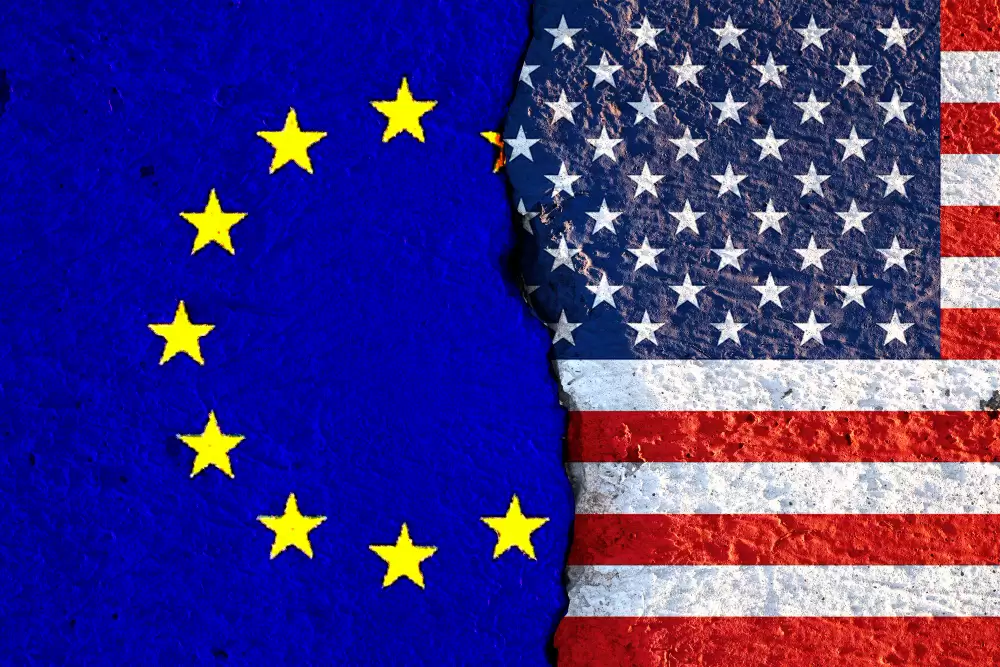Since his first term, Donald Trump’s narrative towards Europe has been shaped by the notion that Europeans have unfairly benefited from trade agreements with the US while freeriding on American security guarantees. After declaring “wins” in trade wars with Canada and Mexico, his trophy-seeking ambitions will soon turn to Europe. But what exactly the EU can expect on the trade front is anything but straightforward.
Trump and his cabinet have differing views on how to use tariffs and to what ends, despite a shared objective of reducing America’s trade deficit with Europe, spelled out in the “America First” trade policy. As a result, there will be at least two distinct approaches to trade negotiations coming from Washington; the EU will need to protect its interests against both. In particular, the interplay between the China hawks and the deal-making instincts of the president and the billionaires around him will be crucial for Europeans to monitor.
Jamieson Greer, Trump’s pick for US trade representative, is a true economic nationalist who sees tariffs as a necessary tool to bring production back to America. He is particularly focused on America’s trade deficit with Europe in agriculture and the automotive industry. Greer will seek to correct this by pressing the EU to lower its tariffs and eliminate non-tariff barriers. He champions hardline economic and tariff measures against China to offset perceived unfair trade practices, as well as home-shoring critical industries and denying China dominance in the industries of the future.
Greer will expect the EU to align with the US on China in technology and export controls, inbound and outbound investment screening, and supply chain resilience. By showing willingness to collaborate in some of these issues, Europe could use this as leverage to soften his approach to tariffs on EU exports.
Trump and the oligarchs: Tariffs as bargaining chips
On the other hand, Trump’s own approach to tariffs has often little to do with economic issues. Despite his longstanding irritation with the trade deficit with the EU, he tends to use tariffs as tools to extract concessions on non-trade issues, as demonstrated by the resolution of recent confrontations with Canada and Mexico.
Furthermore, Trump and his billionaire advisors, along with some of his cabinet members, do not share the same level of commitment to the maximalist China policy that Greer and other China hawks do. Trump’s track record during his first term suggests he was more interested in economic deals with China rather than tightly controlling technology transfers or protecting Taiwan. Notably, he invited Chinese president Xi Jinping and TikTok CEO Shou Zi Chew to his inauguration, and on his first day in office, he overrode the congressional ban on TikTok. His close advisor Elon Musk has direct business interests in China that he is likely keen to protect. Unsurprisingly, the 10% tariff on China is relatively modest compared to Trump’s electoral pledge of 60% or the revocation of China’s normal trading relations status—goals championed by China hawks like Greer and Secretary of State Marco Rubio.
Ultimately, Trump and his business advisors are likely to adopt a more transactional approach, showing less focus or insistence on rigid policies. In other words, Trump might threaten a lot but is likely to back down if he can claim a victory.
How Europeans can navigate the two camps
That does not mean that Europeans will be spared from Greer’s demands. He and Trump are certainly committed to reducing US trade deficits: Trump’s recent executive order explicitly tasks the USTR to review the tariff structure of trading partners in order to impose reciprocal tariffs. While the president may not care as much about containing China, he will not oppose Greer’s call for the EU to adopt economic measures aimed at decoupling from China. Conversely, Trump will focus on securing a victory, raising the question of what kind of win Europeans can offer him.
Juggling these demands, while maintaining a minimum degree of unity on a strategy to respond, will be the EU’s greatest challenge. The EU will need to protect its interests by appeasing Trump’s hunger for a winning narrative while pursuing a more serious cooperation with Greer on China. At the same time, the EU will need to convincingly threaten retaliation on US businesses if tariffs are imposed.
The EU’s “welcome package” for the Trump administration is a good start, offering both China-related carrots and threats of retaliatory measures if the US imposes tariffs. But achieving unity on all China-related issues will be difficult as economic security remains a national competence for member states. In fact, Trump’s aggressive approach is already threatening to reverse the nascent EU-US cooperation on China which started under the Biden administration.
An initial step could be to focus on building supply chain resilience in sectors vital for both the EU and the US. Reducing US and EU dependency on cheap Chinese imports for commonly used pharmaceuticals, such as paracetamol or ibuprofen, is of interest to both the US and the EU. So is protecting the European market from a massive influx of artificially cheap Chinese goods that undermine its manufacturing base.
The EU’s package will only be effective if paired with shrewd tactics to prevent the imposition of tariffs or at least influence the order of adversarial measures from Washington. The threat of retaliation must be credible and should focus on areas where the EU can inflict economic pain on the US. The EU needs to take a page out of Canada’s response to Trump, which showed an impressive degree of preparation and skilful public relations: when the US announced it would exempt Canadian oil from tariffs to minimise its own pain, Canada threatened an export tax on oil to maximise the impact.
Since trade falls within the EU’s competence, maintaining unity on trade matters might be easier than on China. Also, in the light of widespread farmers’ protests and rising populism, the US push on agriculture concessions is likely to have a unifying effect: no member state will want to yield to US demands for opening the market for hormone-treated beef or chlorinated chicken. But gestures on other imports, such as LNG, could be made.
In striving for maximum unity, the EU will also need to communicate well. Trump thrives on conflicts that result in self-defined wins, so European officials should help shape his victory narrative without compromising core European interests. The EU is already preparing to do this in various areas, including stepping up on security, buying more LNG, job creation in the US, or ensuring that the US and Europe work together to “beat” China. Europeans could also think outside of the box and have member states like Spain offer to take in Latin American migrants to address labour shortages in agriculture, fast food, and patient care.
Conversely, EU officials should be careful about when to confront the US on big tech and the Digital Services Act. Penalising US tech giants should probably be kept in a back pocket and used as a retaliatory threat rather than imposed immediately.
Europeans need to time their victory offers at moments when Trump needs them, whether as a distraction from domestic problems, to compensate for negative media coverage, or in anticipation of midterms. Credible threat of retaliation is necessary to avoid the trade war, which would be very detrimental to the EU given its dire need for investment, especially on defence. Given how high stakes are, there will be instances where Europeans will simply have to go against their instincts.
About the Author
Majda Ruge is a senior policy fellow with the Wider Europe programme at the European Council on Foreign Relations, based in Berlin. Before joining ECFR, she spent three years as a fellow at the Foreign Policy Institute/SAIS at the Johns Hopkins University. She has twice testified as an expert witness at hearings of the US Senate Foreign Relations Committee on the Western Balkans.


